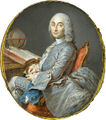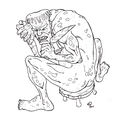Template:Selected anniversaries/September 4: Difference between revisions
No edit summary |
No edit summary |
||
| Line 2: | Line 2: | ||
File:César François Cassini de Thury.jpg|link=César-François Cassini de Thury (nonfiction)|1784: Astronomer and cartographer [[César-François Cassini de Thury (nonfiction)|César-François Cassini de Thury]] dies. In 1744, he began the construction of a great topographical map of France, one of the landmarks in the history of cartography. Completed by his son Jean-Dominique, Cassini IV and published by the Académie des Sciences from 1744 to 1793, its 180 plates are known as the Cassini map. | File:César François Cassini de Thury.jpg|link=César-François Cassini de Thury (nonfiction)|1784: Astronomer and cartographer [[César-François Cassini de Thury (nonfiction)|César-François Cassini de Thury]] dies. In 1744, he began the construction of a great topographical map of France, one of the landmarks in the history of cartography. Completed by his son Jean-Dominique, Cassini IV and published by the Académie des Sciences from 1744 to 1793, its 180 plates are known as the Cassini map. | ||
||1797 | ||1797: Coup of 18 Fructidor in France. | ||
||1826 | ||1826: Martin Wiberg born ... philosopher and engineer. | ||
||1848 | ||1848: Lewis Howard Latimer born ... inventor (d. 1928) | ||
||1846 | ||1846: Daniel Burnham born ... architect, designed the World's Columbian Exposition. | ||
||Ernst Heinrich Bruns | ||1848: Ernst Heinrich Bruns born ... mathematician and astronomer, who also contributed to the development of the field of theoretical geodesy. Pic. | ||
||1848 | ||1848: Lewis Howard Latimer born ... inventor. | ||
File:Culvert Origenes.jpg|link=Culvert Origenes|1881: Writer and philosopher [[Culvert Origenes]] arrives at [[New Minneapolis, Canada|New Minneapolis]], where he will write his well-known essay, ''A Noble Experiment''. | File:Culvert Origenes.jpg|link=Culvert Origenes|1881: Writer and philosopher [[Culvert Origenes]] arrives at [[New Minneapolis, Canada|New Minneapolis]], where he will write his well-known essay, ''A Noble Experiment''. | ||
| Line 20: | Line 20: | ||
File:Gustav Robert Kirchhoff.jpg|link=Gustav Kirchhoff (nonfiction)|1883: Physicist and crime-fighter [[Gustav Kirchhoff (nonfiction)|Gustav Kirchhoff]] uses the emission of black-body radiation by heated objects to detect and prevent [[crimes against mathematical constants]]. | File:Gustav Robert Kirchhoff.jpg|link=Gustav Kirchhoff (nonfiction)|1883: Physicist and crime-fighter [[Gustav Kirchhoff (nonfiction)|Gustav Kirchhoff]] uses the emission of black-body radiation by heated objects to detect and prevent [[crimes against mathematical constants]]. | ||
||1886 | ||1886: American Indian Wars: After almost 30 years of fighting, Apache leader Geronimo, with his remaining warriors, surrenders to General Nelson Miles in Arizona. | ||
File:George_Eastman.jpg|link=George Eastman (nonfiction)|1888: [[George Eastman (nonfiction)|George Eastman]] registers the trademark Kodak and receives a patent for his camera that uses roll film. | File:George_Eastman.jpg|link=George Eastman (nonfiction)|1888: [[George Eastman (nonfiction)|George Eastman]] registers the trademark Kodak and receives a patent for his camera that uses roll film. | ||
| Line 33: | Line 33: | ||
||1891: Fritz Todt born ... engineer and politician. | ||1891: Fritz Todt born ... engineer and politician. | ||
||1893: Felix Klein said, "The proof of the transcendency of pi will hardly diminish the number of circle-squarers, however; for this class of people has always shown an absolute distrust of mathematicians and a contempt for mathematics that cannot be overcome by any amount of demonstration." - Klein in The Evanston Colloquium: Lectures on Mathematics (1894), pp. 52-53. | |||
||1896: Antonin Artaud born ... actor, director, and playwright. | ||1896: Antonin Artaud born ... actor, director, and playwright. | ||
| Line 44: | Line 46: | ||
||1916: José Echegaray y Eizaguirre dies ... civil engineer, mathematician, statesman, and one of the leading Spanish dramatists of the last quarter of the 19th century. He was awarded the 1904 Nobel Prize for Literature "in recognition of the numerous and brilliant compositions which, in an individual and original manner, have revived the great traditions of the Spanish drama". | ||1916: José Echegaray y Eizaguirre dies ... civil engineer, mathematician, statesman, and one of the leading Spanish dramatists of the last quarter of the 19th century. He was awarded the 1904 Nobel Prize for Literature "in recognition of the numerous and brilliant compositions which, in an individual and original manner, have revived the great traditions of the Spanish drama". | ||
||1923 | ||1923: Maiden flight of the first U.S. airship, the USS Shenandoah. | ||
||Leo Apostel | ||1925: Leo Apostel born ... philosopher and professor at the Vrije Universiteit Brussel and Ghent University. Apostel was an advocate of interdisciplinary research and the bridging of the gap between exact science and humanities. | ||
||1913 | ||1913: Mickey Cohen born ... mob boss. | ||
||1913 | ||1913: Stanford Moore born ... biochemist and academic, Nobel Prize laureate. | ||
||1927 | ||1927: John McCarthy born ... computer scientist and academic. | ||
||1941 | ||1941: World War II: A German submarine makes the first attack against a United States ship, the USS Greer. | ||
||1949 | ||1949: The Peekskill riots erupt after a Paul Robeson concert in Peekskill, New York. | ||
||Albert Schweitzer | ||1965: Albert Schweitzer dies ... theologian, organist, writer, humanitarian, philosopher, and physician. | ||
||1967 | ||1967: Vietnam War: Operation Swift begins when U.S. Marines engage the North Vietnamese in battle in the Que Son Valley. | ||
||1969: Marcel Riesz born ... mathematician, known for work on summation methods, potential theory, and other parts of analysis, as well as number theory, partial differential equations, and Clifford algebras. | ||1969: Marcel Riesz born ... mathematician, known for work on summation methods, potential theory, and other parts of analysis, as well as number theory, partial differential equations, and Clifford algebras. | ||
Revision as of 10:31, 4 September 2018
1784: Astronomer and cartographer César-François Cassini de Thury dies. In 1744, he began the construction of a great topographical map of France, one of the landmarks in the history of cartography. Completed by his son Jean-Dominique, Cassini IV and published by the Académie des Sciences from 1744 to 1793, its 180 plates are known as the Cassini map.
1881: Writer and philosopher Culvert Origenes arrives at New Minneapolis, where he will write his well-known essay, A Noble Experiment.
1882: Thomas Edison flips the switch to the first commercial electrical power plant in history, lighting one square mile of lower Manhattan. This is considered by many as the day that began the electrical age.
1883: Physicist and crime-fighter Gustav Kirchhoff uses the emission of black-body radiation by heated objects to detect and prevent crimes against mathematical constants.
1888: George Eastman registers the trademark Kodak and receives a patent for his camera that uses roll film.
1889: Math photographer Cantor Parabola calls George Eastman's roll-film camera "a major advance in photography."
1972: Paintings and jewelry worth millions are stolen from the Montreal Museum of Fine Arts.
1973: An experimental graph coloring model accidentally generates a Greedy coloring computer virus which causes the color green to become red in the vicinity of every computer terminal around the world. The virus will be eliminated several hours later by APTO troubleshooters, restoring green to its normal appearance.







